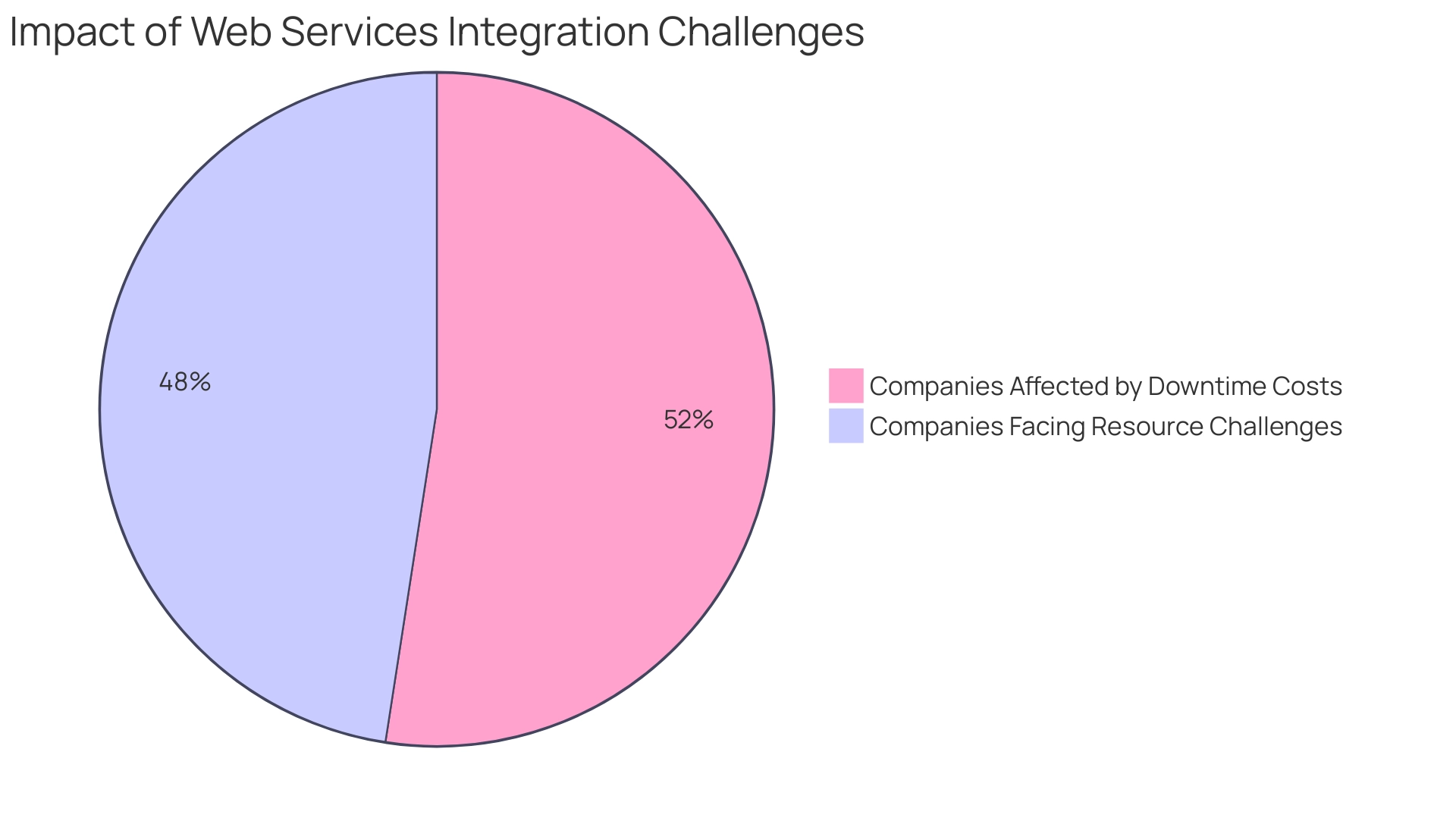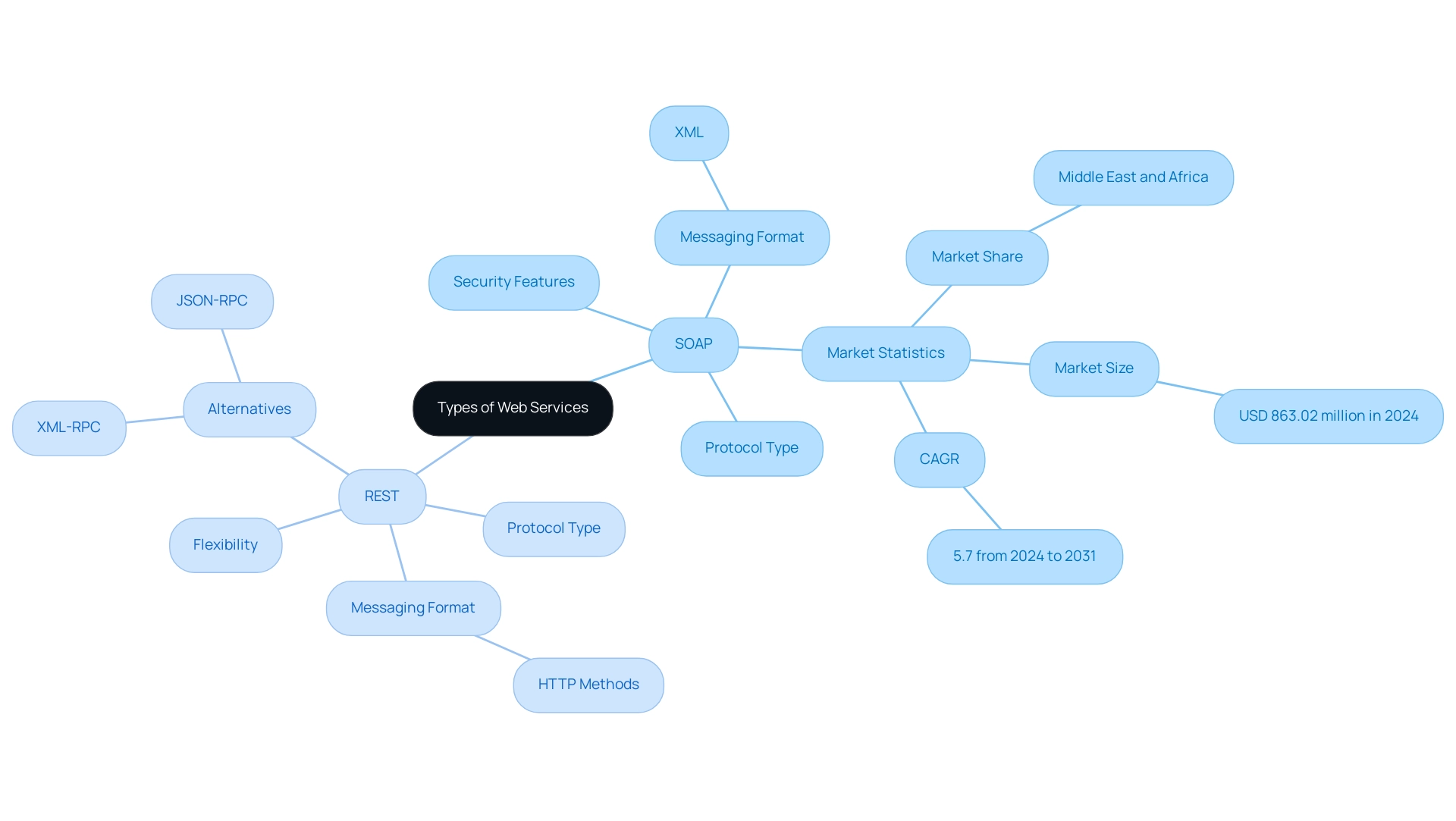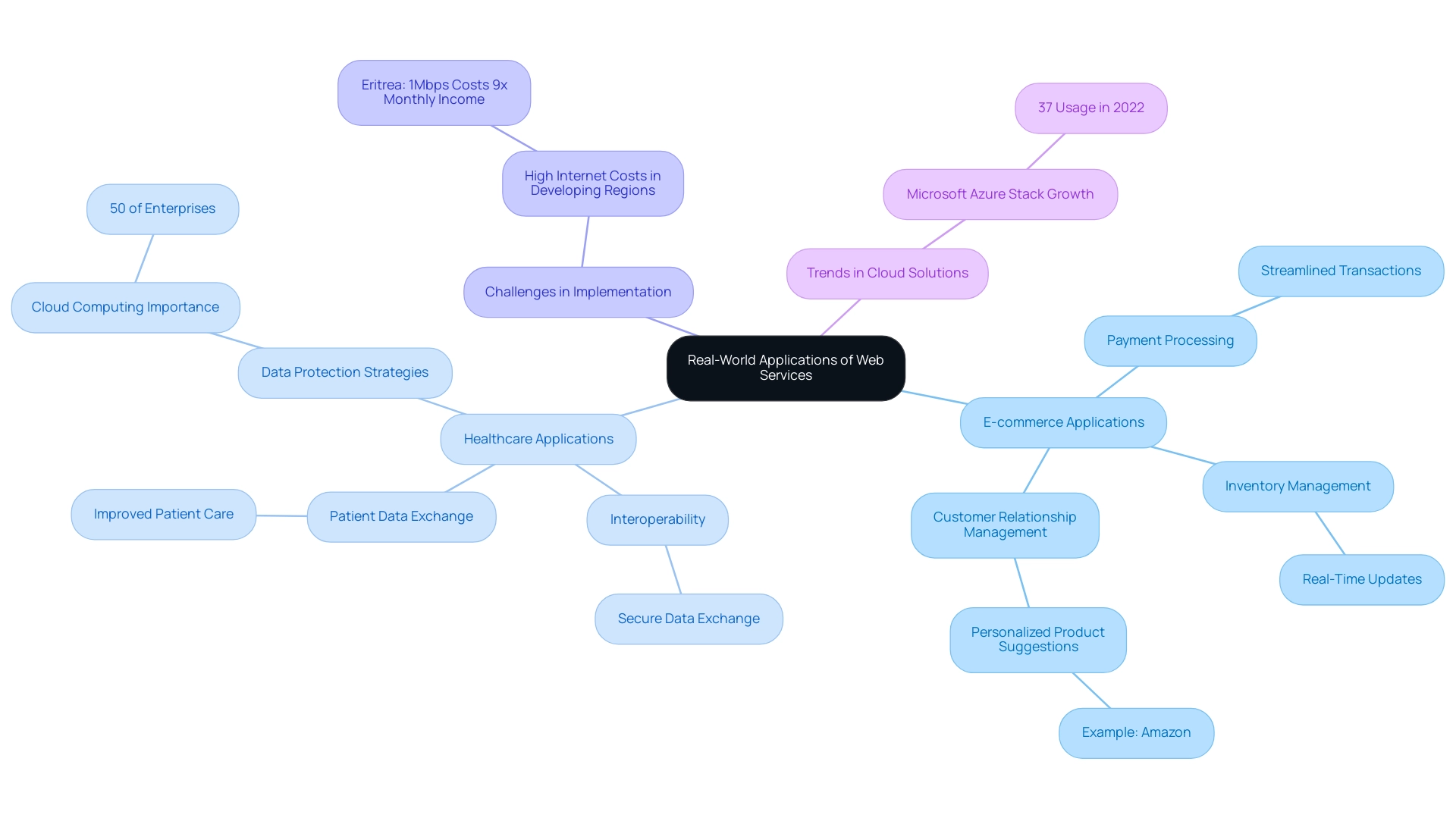Introduction
In a rapidly evolving digital landscape, the integration of web services has become a cornerstone for businesses aiming to enhance operational efficiency and drive innovation. These standardized frameworks facilitate seamless communication between diverse applications, enabling organizations to navigate the complexities of modern technology without the burden of extensive custom coding.
As companies increasingly rely on cloud computing and interconnected systems, understanding the various types of web services—such as SOAP and REST—and their real-world applications becomes essential. From e-commerce giants like Amazon to critical healthcare systems, the transformative potential of web services is evident across industries.
However, the journey toward effective implementation is not without its challenges, including security concerns and the integration of legacy systems.
This article delves into the multifaceted world of web services, exploring their benefits, applications, and the hurdles organizations must overcome to fully leverage their capabilities.
Defining Web Services: An Overview
Web solutions represent a standardized framework for integrating web services applications through open standards over an internet protocol backbone. This approach allows disparate applications from various sources to communicate seamlessly without the need for custom coding, which can be both time-consuming and costly. Web functionalities can be understood as an array of protocols and tools designed to facilitate interaction between different systems, regardless of their underlying architecture.
This capability for interoperability is critical in today's digital ecosystem, where organizations often depend on a multitude of web services applications and other platforms to function efficiently. Significantly, 86% of manufacturing companies have indicated that just an hour of system downtime could lead to losses surpassing $300,000, highlighting the financial necessity for strong web integration. Moreover, 78% of companies encounter difficulties because of insufficient resources or expertise, emphasizing the necessity for effective web solutions implementation.
As online computing continues to lead, with the U.S. and Western Europe representing 82% of the global market, the reliance on efficient web services applications to optimize operations and reduce inefficiencies is more pertinent than ever. According to Kepios, ‘Facebook’s global ad reach skews 57 percent male to 43 female,’ illustrating the importance of understanding user demographics in web integration. This context is vital as areas excelling in cloud computing impact global trends and advancements in web technologies, as shown by the case study on regional cloud computing supremacy.

Types of Web Services: SOAP, REST, and More
Web solutions are predominantly categorized into two primary types: SOAP (Simple Object Access Protocol) and REST (Representational State Transfer).
- SOAP is a highly structured protocol that utilizes XML for message formatting, and it leverages other application layer protocols such as HTTP and SMTP for message negotiation and transmission. This framework is particularly esteemed for its robust security features, making it an ideal choice for enterprise-level applications that require reliability and consistency.
- In fact, SOAP APIs are commonly utilized for web services applications that necessitate enhanced security, reliability, and consistency.
-
According to Cognitive Market Research, the Middle East and Africa Soap Market held 2% of the global revenue with a market size of USD 863.02 million in 2024 and is projected to grow at a compound annual growth rate (CAGR) of 5.7% from 2024 to 2031.
-
REST is more of an architectural style rather than a strict protocol.
- It employs standard HTTP methods, offering a lightweight and flexible approach that facilitates easier integration, especially prevalent in mobile applications and various web APIs.
- Additionally, simpler alternatives for remote procedure calls, such as XML-RPC and JSON-RPC, exist and can cater to less complex requirements.
As organizations continue to assess their web services applications needs, understanding the strengths and limitations of both SOAP and REST is crucial for making informed decisions.
Furthermore, the Bath & Body Soap Segment, which includes diverse cleansing products designed for personal hygiene and skin care, significantly contributes to the overall soap market, driven by increased hygiene awareness and a focus on natural ingredients. This real-world application underscores the relevance of SOAP in enterprise contexts, particularly in sectors where security and compliance are paramount.

Real-World Applications of Web Services
Web services applications are essential to numerous solutions across different sectors, greatly influencing how companies function. In e-commerce, they streamline processes like payment processing, inventory management, and customer relationship management by facilitating seamless interactions among diverse web services applications. Our customized e-commerce solutions, supported by over 20 years of global experience, enhance critical KPIs such as retention rates and Average Order Value (AOV), ensuring that organizations can thrive while generating incremental revenue.
For instance, Amazon utilizes online solutions to integrate its extensive array of functionalities, which includes personalized product suggestions and real-time order tracking, thereby enhancing the shopping experience for customers and driving sales.
In the healthcare sector, online solutions are pivotal for achieving interoperability between different systems. They enable secure and efficient exchange of patient data across various platforms, which is crucial for improving patient care and operational efficiency. The ability to share data securely among healthcare providers not only enhances the quality of care but also supports organizations in developing comprehensive data protection strategies.
Significantly, half of the surveyed enterprises regard online computing as an essential component of their data protection plan, further emphasizing the importance of web technologies in contemporary healthcare administration.
It's also vital to take into account the wider context in areas such as Eritrea, where 1Mbps of fixed internet bandwidth generally costs approximately nine times more than the average monthly income. This underscores the challenges encountered in implementing web solutions, particularly in developing regions. Moreover, according to Flexera, Microsoft Azure Stack usage increased to 37% in 2022, displacing VMware vSphere from the leading position, which indicates the growing dependence on web services applications within cloud solutions.
As we progress into 2024, the incorporation of web services applications within e-commerce and healthcare continues to develop, showcasing their transformative effect on industry growth and efficiency while enhancing community value aligned with internal objectives. Our solutions not only cater to specific industry needs but also foster community engagement, ensuring that the value we build resonates with both businesses and their customers.

Benefits and Challenges of Implementing Web Services
The execution of web services applications brings a multitude of advantages, including improved interoperability, scalability, and cost-effectiveness. Organizations can streamline operations, enhance data accuracy, and boost overall efficiency. For example, online computing represented 82% of global activity in the U.S. and Western Europe, with IBM reporting a revenue of $25.1 billion in 2020, reflecting a year-over-year growth rate of 20%.
This trend is echoed by Cody Slingerland, a FinOps certified practitioner, who emphasizes that web services applications can transform operational frameworks across industries. However, challenges are inherent in this transition. Security concerns, particularly misconfiguration of cloud platforms, have emerged as the primary cause of data breaches, necessitating a robust focus on securing data transmission, especially in sectors like finance and healthcare.
Furthermore, integrating legacy systems with modern web services applications poses a complex challenge for many organizations, as these older systems may not easily interface with new technologies. Addressing these issues requires strategic planning, investment in advanced security measures, and comprehensive employee training. As the terrain of online offerings continues to evolve, companies must stay alert and flexible to guarantee successful execution, especially as the market expects additional growth and innovation in 2024.
Moreover, over a third of web design agencies charge between $1,000 and $1,500 for their services, illustrating the financial implications of adopting web services applications and lowering entry barriers for small businesses, with 87% of small business owners intending to create a website.

Conclusion
The exploration of web services reveals their indispensable role in modern business operations, marked by their ability to facilitate interoperability among diverse applications through standardized frameworks. With the surge in cloud computing, organizations are increasingly recognizing the necessity of web services, such as SOAP and REST, to enhance efficiency and drive innovation. These technologies empower businesses, from e-commerce giants like Amazon to critical healthcare systems, to streamline processes, improve data accuracy, and elevate customer experiences.
However, the path to successful implementation is fraught with challenges, including security risks and the integration of legacy systems. Addressing these obstacles requires:
- Strategic planning
- Robust security measures
- Ongoing employee training
As businesses navigate this complex landscape, they must remain agile, adapting to technological advancements and market demands to fully leverage the transformative potential of web services.
Ultimately, embracing web services is not merely a technological upgrade; it is a strategic imperative that can lead to significant operational improvements and competitive advantages. Organizations that prioritize effective web services integration will be well-positioned to thrive in an increasingly interconnected digital ecosystem, ensuring they meet the evolving needs of their customers while driving growth and innovation in their respective industries.





